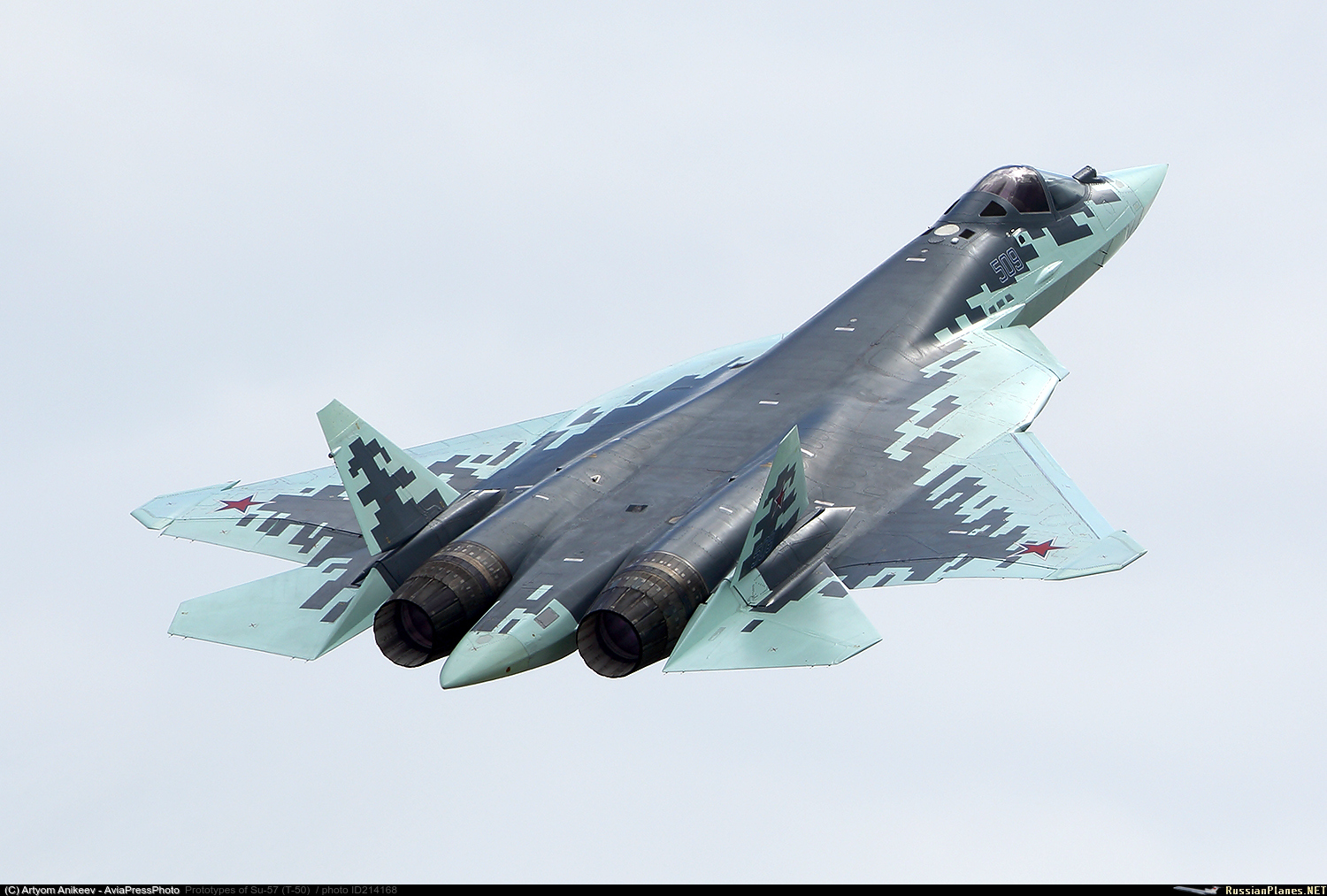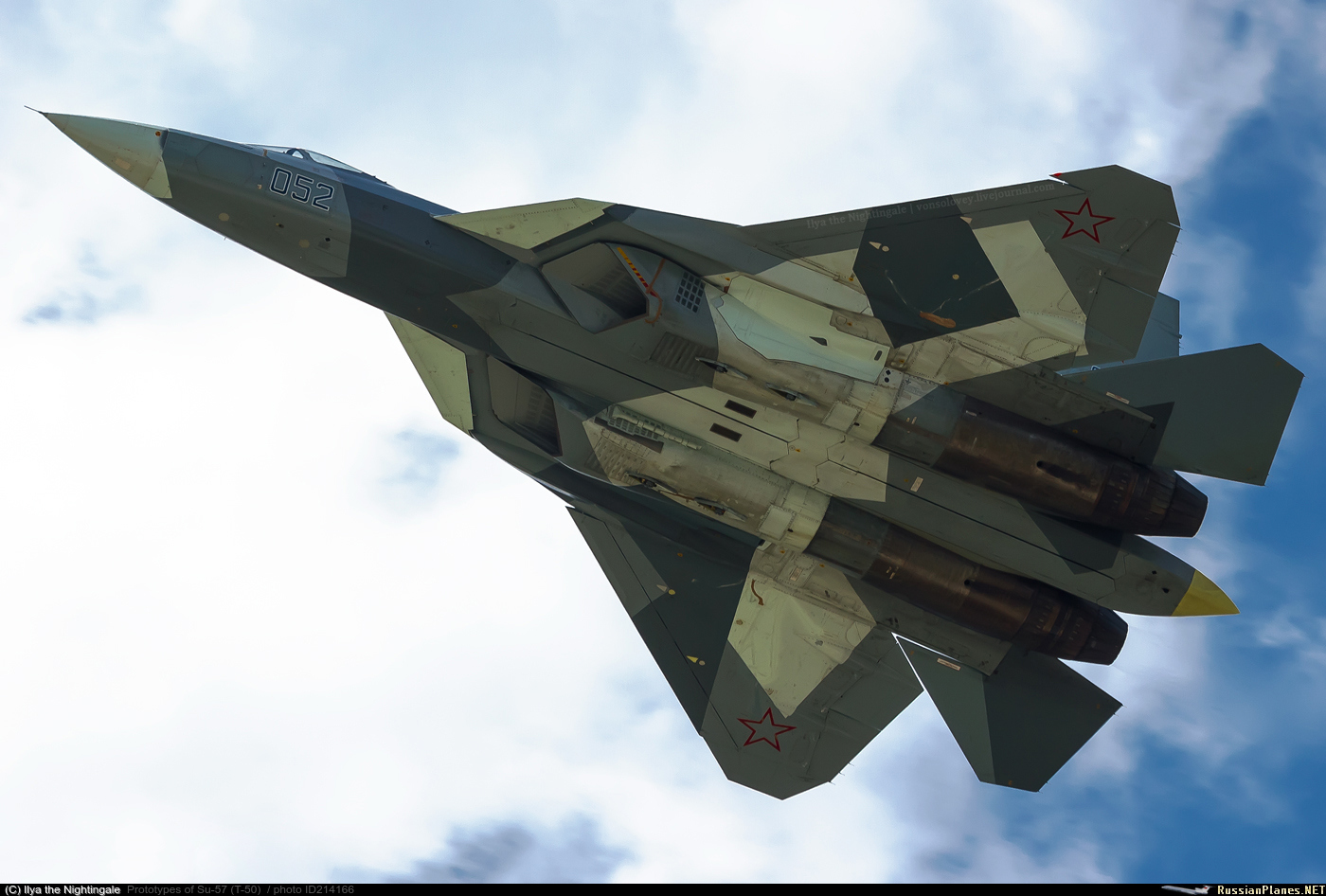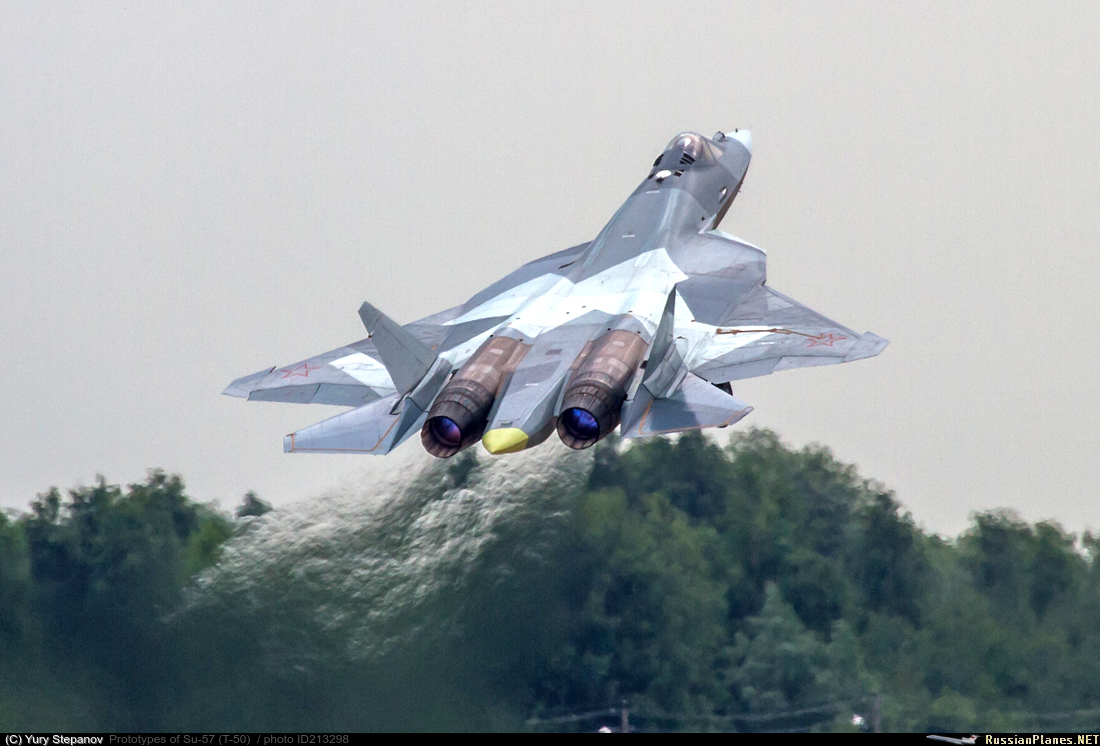You are using an out of date browser. It may not display this or other websites correctly.
You should upgrade or use an alternative browser.
You should upgrade or use an alternative browser.
Russian Su-57 Aircraft Thread (PAK-FA and IAF FGFA)
- Thread starter A Bar Brother
- Start date
some recent pictures which caught my interest:

reportedly these are 052, 054:

052:

Yes the center picture is 052 and 054, the little sisters, and no the PAK-FA is NOT a blank space on the radar screen?? LOL and our friends little post to answer Master Forbin made it clear that longer ducts in the front, means the engines "hang out" in the back, PAK-FA exactly, and those bad boys (the engines) provide and excellent radar return!
b787
Captain
the question is most combat is a head on face off, and all aircraft had infra red signatureYes the center picture is 052 and 054, the little sisters, and no the PAK-FA is NOT a blank space on the radar screen?? LOL and our friends little post to answer Master Forbin made it clear that longer ducts in the front, means the engines "hang out" in the back, PAK-FA exactly, and those bad boys (the engines) provide and excellent radar return!

so if a fighter is approaching pakfa head on needs to get close why? the rwr will let know PAKFA a missile has been launched at it, if the missile is launched 180 km away PAKFA super cruises so has high odds of evading it, closer the enemy gets then Pakfa sees it.

trying to hunt PAKFA is not easy, it is fast with T-30 engines will simply be very difficult to hunt, because in a tail on chase, PAKFA is a jack rabbit, it has variable geometry intakes, allowing for Mach 3 speeds, i do not know PAKFA top speed, but i guess it is probably near Mack 2.3-Mach 2.6, trying to catch something that cruises at Mach 1.8, and reaches speeds of Mach 2.5 well is not an easy task
According a part of articles/experts a 5th generation need to have sensors fusion in first which is not the case of PAK-FA and J-20 according actual infos after it is certain they are surely more capables than actual 4th generation fighters.If a Su-27 with radar reduction modification is a 5-th generation fighter, then Rafale with radar reduction features could be called a 5-th generation fighter, right?

I have PAG-FA frontal RCS the less big for obvious reasons to 0.01 m2, - 20 dBsm approx. ofc on the others sides in general all have + 10 dBsm minimum
Last edited:
More old Mig-31 capable mach 2.8 and F-15C 2.5, the record for SR-71/A-12 fighter variant mach 3.3 and Mig-25 mach 3.2 but in fact in practice with engine limit mach 2.8 !the question is most combat is a head on face off, and all aircraft had infra red signature
so if a fighter is approaching pakfa head on needs to get close why? the rwr will let know PAKFA a missile has been launched at it, if the missile is launched 180 km away PAKFA super cruises so has high odds of evading it, closer the enemy gets then Pakfa sees it.

trying to hunt PAKFA is not easy, it is fast with T-30 engines will simply be very difficult to hunt, because in a tail on chase, PAKFA is a jack rabbit, it has variable geometry intakes, allowing for Mach 3 speeds, i do not know PAKFA top speed, but i guess it is probably near Mack 2.3-Mach 2.6, trying to catch something that cruises at Mach 1.8, and reaches speeds of Mach 2.5 well is not an easy task
Engineer
Major
Even if we assume that top-speed figure is real, the PAKFA would still be in a disadvantage. Having the larger radar signature means the PAKFA will get shot at first. Sure, the PAKFA could run, but the opponents could also fire more missiles. Thereafter, the PAKFA would be forced to dodging missiles and have no initative in battle.More old Mig-31 capable mach 2.8 and F-15C 2.5, the record for SR-71/A-12 fighter variant mach 3.3 and Mig-25 mach 3.2 but in fact in practice with engine limit mach 2.8 !
b787
Captain
PAKFA does not work alone, you add S-400 and S-500, to understand as a system, you have to see, F-15 does not supercruise, MiG-31 is an interceptor so it is not agile.More old Mig-31 capable mach 2.8 and F-15C 2.5, the record for S-400 fighter variant mach 3.3 and Mig-25 mach 3.2 but in fact in practice with engine limit mach 2.8 !
PAKFA combines the better than the F-15's agility with the cruising capability of MiG-31, the MiG-31 can cruise with afterburner at Mach 2.34, but PAKFA does it better, no afterburner needed albeit at Mach 1.8
However PAKFA will have much better acceleration than Blackbirds and Foxhound, which are 1.5 as heavy in the case of the MiG-31; and it is 4-5 times lighter than the blackbird,
PAKFA basically will hunt targets that might had survived S-400 and S-500s, PAKFA also has several radars operating in different wavelength bands, these can tell the PAKFA where to point the IRST, If you tell where to look to an IRST, you will find the stealth fighter, add the airborne and ground radar which can data link information, further more PAKFA's frontal RCS is very likely 0.1.
will it work? who knows, but any stealth fighter will use similar tactics to hunt stealthy opponents
Last edited:
Even if we assume that top-speed figure is real, the PAKFA would still be in a disadvantage. Having the larger radar signature means the PAKFA will get shot at first. Sure, the PAKFA could run, but the opponents could also fire more missiles. Thereafter, the PAKFA would be forced to dodging missiles and have no initative in battle.
A thing surely PAK FA is in Soviet/Russian tradition a fighter more " rustic " to be used in a country which don' t have means of USA and to beused in more rough conditions weather etc...more easy to maintain.
Technical is a thing i a not very passionated by it, combat capability mainly and again more the Fleets so normaly PAF FA replace i think in first old Su-27 P/S remains about 120 with UB including Navy ( have 15 )
Other legacy Mig-29A/S/UB remains about 120 in only now 2 Front Line Rgts ( mainly in tsts/training units ) and one to Kursk have begin transition on SU-30SM which have yet replaced this type in 2 Rgts.
And the 52 recent Mig-29SMT/UBT don't need replacements
Ofc I don't include fighters in reserve for numbers only ops.
I add rumors for 24 Mig-35.
I think we can guestimate Russian AF want for mid term about 200 and the whole point is can afford ?
With an inferior military budget coz oïl price etc...
Seems 12 combat capable... for 2019 a Squadron 1/2 Rgt in general some have 3 Sqns.
And her price is considered to 100 millions $, other heavy fighters Sukhoi want 40 -70 ( Su-35 ) Russians and Chinese build cheaper coz the law, working conditions are different and people earns less etc... not important.
So 100 millions $ for a 5th generation is a good price( close F-35A ) but clearly more than a Su-35 and much more than a SU-30SM, the Su-34 obviously is not to be replaced by PAK FA .
Also important in contrary to USAF which have plans since 10 years to have a full stealth fighters Fleet 1763 F-35A + about 200 F-22 complete according actual orders for about 2037 with séquestrations delay of about 5 + years ?
Russian AF and Chinese also want keep no Stealth a mixed flleet coz new are more expensives and USAF have a budget of 150 millions/year !
Despite stealth advantage can be interesting a mixed more affordable and numerous as want USN and a bit Aussies if stealth is not also good than planned hummm... different choice " more safe " the USAF choice remains a bit ambitious and the number is essential not only the quality.
Last edited:
Seems 12 PAK FA combat capable... for 2019 a Squadron 1/2 Rgt in general some have 3 Sqns.Seems 12 combat capable... for 2019 a Squadron 1/2 Rgt in general some have 3 Sqns
150 envisage less than planned and delays enough logic.
For 2025 i think about 60 about 10/year ?
The Russian Air Force is expected to procure more than 150 PAK FA aircraft, the first of which is slated to be delivered in 2016. India plans on acquiring modified PAK FA as a part of its Fifth Generation Fighter Aircraft (FGFA) program. It originally planned on buying 166 single-seat and 44 two-seat variants, but this has been reduced to 130-145 single-seat aircraft and the requirement for 45-50 twin-seat fighters has been dropped by 2014. The plan on purchasing the first 10 evaluation example aircraft after 2012 and then 60 production standard aircraft after 2016.
To consider AF have 1130 fighters-Bombers ( Navy 170 ) and also 140 Bombers.
So in proportion Flankers remains in big majority for long time.
Last edited:
b787
Captain
PAKFA will work with along side thisSeems 12 PAK FA combat capable... for 2019 a Squadron 1/2 Rgt in general some have 3 Sqns.
150 envisage less than planned and delays enough logic.
For 2025 i think about 60 about 10/year ?
.
A photo of an advanced Russian strike drone, which will be equipped with stealth technologies of Russia's fifth-generation T-50 PAK FA fighter, has emerged on the internet.
© SPUTNIK/ ILIYA PITALEV
The Russian website published a photo of a heavy Russian unmanned aerial vehicle (UAV), which is being developed by the country's Sukhoi company in accordance with the Okhotnik-B project. Sukhoi is a major Russian aircraft manufacturer, headquartered in Moscow.
With characteristics of the new strike drone yet to be disclosed, it was reported that the 20-ton UAV will be equipped with stealth technologies of the new Russian fifth-generation T-50 PAK FA fighter jet and will be capable of flying as a sixth-generation fighter.
Flight tests of the Okhotnik-B are due to begin already in 2018, and in 2020 it is expected to enter service with the Russian Armed Forces.
Hunter-B drone project
Judging by the Okhotnik-B photo, the drone is being developed in line with the "flying wing" scheme stipulating a three-column chassis. In the same way, the Skat drone was created by the Russian aircraft corporation MiG in the 1990s, something that prompted experts to suggest that some Skat technologies may be used in the Okhotnik-B.
According to unconfirmed reports, the range of the Russian heavy drone will stand at about 6,000 kilometers. It means that the UAV may be equipped with the turbojet two-circuit engine AL-31F, which is used in the Russian fighters of the Su-27 family.
In an interview with Sputnik, Russian military expert Denis Fedutinov, for his part, suggested that the Okhotnik-B's silhouette may look like that of reconnaissance and strike drones developed by European and US companies.
"Judging by data on the Okhotnik-B's takeoff weight, it is safe to assume that its characteristics will be similar to those of the US drone X-47B developed by Northrop Grumman. It can fly at high subsonic speeds, operating within a radius of up to 4,000 kilometers and carrying a diverse target load, including the strike one which weighs up to 2 tons," Fedutinov said.
© SPUTNIK/ VLADIMIR ASTAPKOVICH
Earlier, Russian Deputy Prime Minister Dmitry Rogozin told Sputnik that Russia had swiftly reduced, and is expected to completely eliminate, its lag behind the United States and Israel in the creation of UAVs.
"Concerning the UAVs I should only say that there is no point of speaking about some lagging behind. It has been rapidly reduced and will be completely eliminated soon," Rogozin said in an interview.
He specified that he was speaking about both combat and reconnaissance drones.
